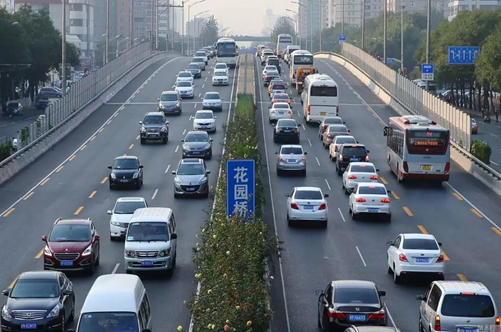TOD should accelerate development of bus lanes
2018.06.14
a84075d3-1d93-4fce-a661-237a6c5616e6.png)
By Cai Shaoqu
According to the 2017 Transport Sector Development Statistical Bulletin (hereafter called the Statistical Bulletin), by the end of 2017, the total mileage of bus lanes was 10,914 kilometers, 1136 kilometers longer than 2016. The cities of Beijing, Shenzhen (in Guangdong province), and Chengdu (in Sichuan province), boast a large number of bus lanes, while the bus lanes in Guangdong, Shandong and Jiangsu provinces exceeded 1,000 kilometers. However, from a nationwide perspective, the bus lane constructions in many cities are still empty.
After the country obtained some achievements of its Public transport priority strategy, the coming focus is to accelerate bus lane constructions.

Bus lanes on the 3rd Ring Road in Beijing have guaranteed the transport efficiency of buses. [Photo by Zhang Fan/ China Transport News]
Bus lanes would attract more bus transport
The competitive edge for buses and cars are the volumes and scales of bus lanes. When the bus lanes form networks, buses naturally become fast and punctual. This would make it more convenient and effective for people to go outside, so more people will be attracted to take buses.
Problems such as congestion and environmental pollution in developed countries and cities that have an advanced automobile society, brought about the idea of bus lanes. Statistics from the British Ministry of Transport indicate that it saves 7 to 9 minutes for buses to run along bus-only lanes than on other lanes.
The Beijing-Tibet Highway is the first expressway in China to have bus lanes. It takes 21 minutes for buses to run on this part of the road, 53% less than before. The average speed is 38 kilometers per hour while it used to be 17 kilometers per hour before introducing the bus lanes.
As the first city to have passed the acceptance check of a national “Public Transit City”, Shanghai municipality boasts 345 kilometers of bus lanes, ensuring the average speed in the central city area is 12 to 15 kilometers per hour and the average speed of buses running in the bus lanes is between 15 and 20 kilometers per hour, thus creating a quality bus transport system.
According to Statistic Bulletin, we can easily see the advantages of bus lanes: traditional bus traffic was reduced by 3% while the BRT traffic relying on bus lanes increased 24.4%.
Compared with cars, BRT in Yichang, Hubei province, attracted passengers that used to drive cars for its faster speed. While the speed of buses increased by 40%, the reduction of cars going in the same direction also contributed to a speed increase of cars. With small investment and high capacity, the “Good Buses” system in Yangzhou, Jiangsu province, achieved a 30-45% speed increase thanks to the bus lanes.
Guaranteeing fairness and convenience of traveling
The nature of transport service equalization is to follow peoples’ expectations for a happy life and make transport benefit all people so that all people can enjoy basic transport rights. Urban transport is one of the basic travel rights. We should guarantee that people have equal rights to use the roads.
So far, transport by cars takes up 30% in some cities in China, exceeding many developed cities overseas, such as Tokyo and London. However, since public transport does not have enough stops, and with its low punctuality rate, public transport is not a priority for many people. The road resources of travelers are also not fair.
Bus lanes are important ways to guarantee the fair use of average road resource. We should guarantee the “exclusiveness” of bus lanes in sections with large traffic volumes, and make bus lanes a real bus equality road.
The nature of bus lanes is prioritizing right of way. To obtain priority in right of way, we should make it an important carrier for bus lanes, and implement it. Meanwhile, cities can also consider accelerating BRT construction to make it an effective way to implement bus lanes, thus making buses a transport for the ordinary people.



